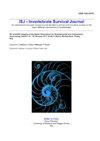GABA immunoreactive elements in the sensory system of the earthworm Eisenia fetida (Annelida, Clitellata)
IF 1.2
4区 农林科学
Q4 IMMUNOLOGY
引用次数: 1
Abstract
The presence of γ-aminobutyric acid (GABA) immunoreactive elements was observed in thesensory system of Eisenia fetida (Annelida, Clitellata). Among the primary sensory cells a high number of labelled cells was found in the epithelium. Using whole-mount preparations and multispectral recording, the number and the distribution pattern of the immunopositive cells were determined in different body segments. Our morphological analysis revealed four typical types of stained primary sensory cells, which could be responsible for the different role of the GABA mediated sensory functions. The peripheral processes of the primary sensory cells ramifying at the border of epithelium and muscular layer produced a basiepidermal network where GABA-positive fibres and their connections were observed. The central processes of the labelled cells projected directly to the ventral nerve cord (VNC) through the segmental nerves to form the ventrolateral and ventromedial sensory longitudinal axon bundles (SLABs). Inhibitory GABA sensory inputs could influence indirectly the activity of the giant motoneurons through the ventrolateral giant axons, and thus the contraction of the body organizing withdrawal and escape reflexes. Applying ultrastructural investigations the synaptic connections of GABA-immunoreactive structures were identified both in the basiepidermal plexus, in the segmental nerves, and in the SLABs of VNC suggesting multistep regulatory effect of GABA in sensory processing of earthworms.蚯蚓感觉系统中GABA免疫反应因子的研究
在羊绒爱森虫(Eisenia fetida)的感觉系统中发现γ-氨基丁酸(GABA)免疫反应因子。在原代感觉细胞中,在上皮中发现了大量的标记细胞。采用全贴装法和多光谱法测定免疫阳性细胞在不同身体部位的数量和分布规律。形态学分析揭示了四种典型的染色原代感觉细胞类型,它们可能负责GABA介导的感觉功能的不同作用。原代感觉细胞的外周突起在上皮和肌层边缘分叉形成基表皮网络,其中gaba阳性纤维及其连接被观察到。标记细胞的中央突通过节段神经直接投射到腹侧神经索(VNC),形成腹外侧和腹内侧感觉纵轴突束(板状)。抑制性GABA感觉输入可通过腹外侧巨轴突间接影响巨运动神经元的活动,从而使机体收缩组织退缩和逃避反射。应用超微结构研究发现,GABA免疫反应性结构的突触连接在基础表皮丛、节段神经和VNC板中均存在,提示GABA在蚯蚓感觉加工中的多步骤调节作用。
本文章由计算机程序翻译,如有差异,请以英文原文为准。
求助全文
约1分钟内获得全文
求助全文
来源期刊

ISJ-Invertebrate Survival Journal
IMMUNOLOGY-ZOOLOGY
CiteScore
2.10
自引率
0.00%
发文量
0
审稿时长
>12 weeks
期刊介绍:
Invertebrate Survival Journal (ISJ) is an international and open access journal devoted to prompt and innovative studies on the basic defense mechanisms in invertebrates, in particular with a view to identifying biotechnologies able to act against derived diseases and related economic damage.
Contributions will be mainly in the form of Letters to the Editor, Visions and Perspectives, Short Communications, Technical Reports, Research Reports, Review, Minireview and Reports of Meetings. Letters to the Editor can be commentaries or perspectives on invertebrate defence mechanisms or replies to the data published in ISJ.
 求助内容:
求助内容: 应助结果提醒方式:
应助结果提醒方式:


